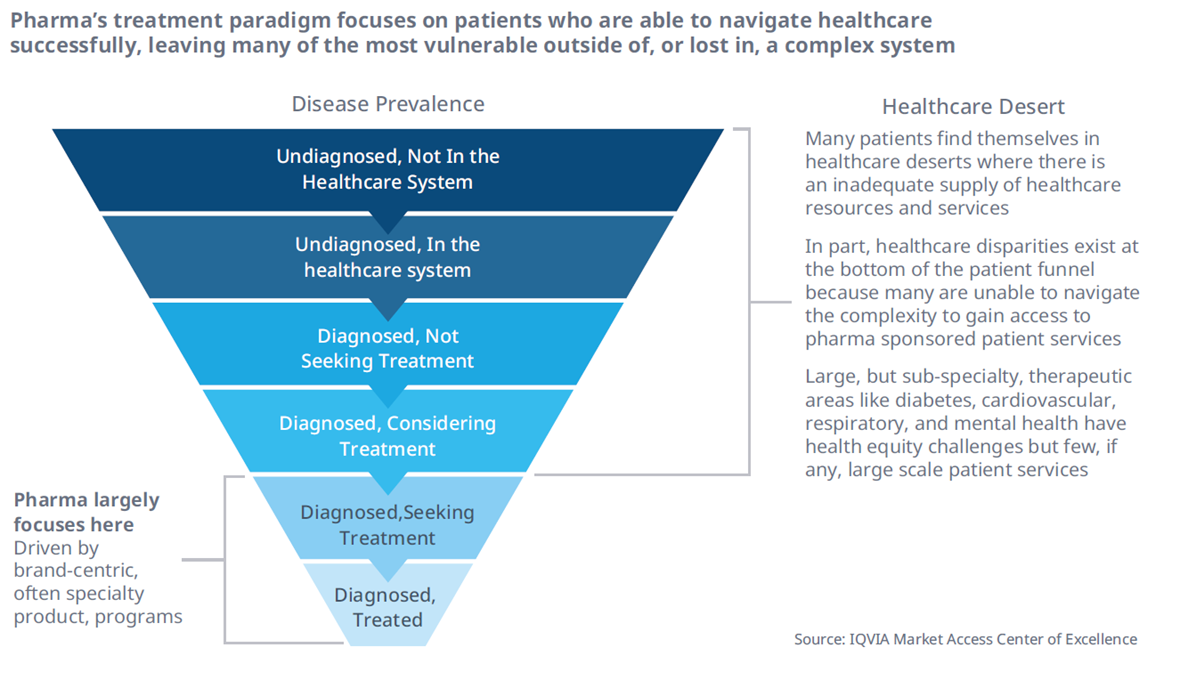















- Locations
- United States
- US Blogs
- Trends Health equity
As we launch into 2022, it’s time for our stakeholders to look ahead and begin making and adjusting their yearly goals. It will be important to explore what trends in pharma are developing and how they may impact those working in the industry. In this blog series, we will explore the top seven trends we see emerging in 2022 and 2023, and how our customers should respond.
Although health equity and inequity have been hot topics for years, we at IQVIA see these areas evolving in 2022 and beyond in new ways. This blog in our trends series explores how it has become more important than ever for stakeholders to make healthcare more accessible.
Health equity
Certain populations in the U.S. face reduced access to healthcare providers, treatment, and health education.1 The COVID-19 pandemic has brought these inequities to the forefront, particularly among people of color. These complex market dynamics contribute to a health equity gap, as large therapeutic areas like diabetes, respiratory, cardiovascular, and mental health often lack support mechanisms because pharma’s traditional patient services support paradigm is focusing on patients who are able to successfully navigate healthcare. This structure leaves many of the most vulnerable patients outside of, or lost in, a complex system (figure 1 below).

As such, there are many patients who could benefit from manufacturer-sponsored patient services programs that are unable to today.
Many pharmaceutical manufacturers offer patient services for their brands. These programs are designed to help patients navigate access and affordability challenges for getting on, and staying on, prescribed therapies. Left to their own ability to navigate a complex, and often confusing, healthcare journey, many patients simply give up or avoid seeking treatment altogether. By comparison, patients who utilize patient service programs are more successfully able to get on physician-prescribed and payer-approved regimens and have proven to be more adherent to those supported treatments over time.
Patient service programs are specifically designed to support patients with complex diseases who are treated with specialty products. However, many programs default to successful patients, are not geographically focused, and are not designed to address the special needs of underserved patient communities, including Black, Hispanic, or other patients of color.
Investments are needed to ensure that patient services programs also target the underserved patient populations and allow them to reach the full potential of available treatments.
Going beyond the historical model, however, is going to require new focus on how patient service programs are financed, designed, and deployed. Financial models that are brand agnostic with multiple sponsors could address the challenges of bringing services to broad, non-specialty but high-need disease areas, such as diabetes, cardiovascular disease, respiratory illnesses, and mental health. Partnering across the industry, government, payer, hospital, and non-governmental organizations will bring down the cost to any one stakeholder to introduce a new Health Equity Patient Service (HEPS) model designed to address disparities.
Broadening the aperture for patient service models to include community outreach through local media, partnering with community organizations, and encouraging the seeking of treatment will help bring patient services to those in most need. Focusing on geographic areas with resource deployment and local representation can quickly supplement scarce healthcare resources by bringing new tools and capacity to market.
The industry is well positioned to support a new paradigm that encourages the appropriate utilization of prescription therapy. Supporting patients in their treatment journey, while focusing on addressing health equity disparities, is a meaningful mechanism to improve access to care.
In our next blog, we will explore affordably economics.
Reference
1 National Academies of Sciences, Engineering, and Medicine; Health and Medicine Division; Board on Population Health and Public Health Practice; Committee on Community-Based Solutions to Promote Health Equity in the United States; Baciu A, Negussie Y, Geller A, et al., editors, Communities in Action: Pathways to Health Equity; Washington (DC): National Academies Press (US); 2017 Jan 11. 2, The State of Health Disparities in the United States.





